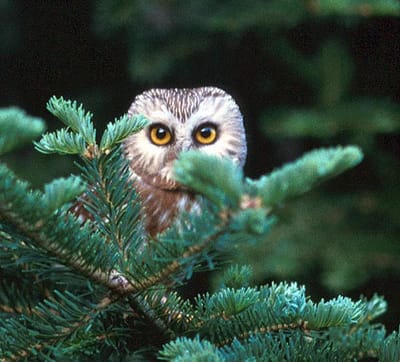The Taiga or Boreal Forest Biome
INFORMATION AND CASE STUDIES
Abiotic Factors
ABIOTIC FACTORS
The taiga or boreal forest is the world's second largest biome, stretching throughout North America, Europe and Asia and covering 11,5% of Earth's land. Canada, Alaska, the United States, Sweden, Finland, Norway, Scotland, Iceland, Russia, Kazakhstan, Mongolia and Japan all have taiga areas, although Canada and Russia have the largest areas by far. In the US and Canada, the terms taiga and boreal forest are not used interchangeably, and instead boreal forest refers to only the more southerly part of the biome.
Due to its high latitude, the taiga has the lowest average annual temperatures next to the tundra. Its climate can be described as subarctic, and is defined by long, cold winters, as well as short mild summers which are usually 1-3 months in length. Summer days can be long and some areas experience midnight sun in summer, as well as polar nights in winter. Permafrost or discontinuous permafrost occur in many regions.
Precipitation levels are generally low but slightly higher in summer. Snow may melt in this time which can contribute to swampy, moist grounds as it still too cool for much evaporation, although in comparison to winter the air is humid. Taigas have infertile, acidic, podzol soils, particularly as low temperatures slow decomposition processes and there is little nutrient gain by precipitation.
Biotic Factors
The TAIGA or BOREAL FOREST Biome
BIOTIC FACTORS
Flora
The taiga is characterized by coniferous forests consisting mostly of pines, spruces and larches. The main species varies, for example the North American taiga is dominated by spruces, the East Siberian taiga by larches. These evergreen trees shade the understory, so shrubs struggle to survive, and mosses and lichens dominate there. Tree size generally decreases with higher latitude.
Conifers are adapted to the taiga in many ways. Their conical shape allows them to shed snow. Slow nutrient release in soil due to low temperatures limits their nutrient supply, making it hard to replace leaves, so they are evergreen. Furthermore, their needles contain resins and other compounds to ward off herbivores, and are waxed to prevent excessive moisture loss.
Some conifers have shallow roots to avoid permafrost. To make the most of the few nutrients in the soil some also have mycorrhiza in their roots, as well as nitrogen fixing bacteria.
Fauna
Taiga foodchains are dominated by carnivorous mammals, often large felids and canids. Rodents are abundant but not very diverse. Some migratory passerine bird groups are very diverse.
Bergmann's rule, which states that populations of a species will have larger body masses in higher latitudes, applies in some but not all cases. Endothermic vertebrates may have a low surface to volume ratio to limit body heat loss, for example the may have short snouts, ears, legs or tails.
A thick layer of fur or feathers can also serve this purpose, and can be thicker during the cold winter than the mild summer. Some ground mammals turn white in winter to become less visible in the snow, either to better evade predators or better catch prey. Some deer can stand on their hind legs to reach the low branches of trees, causing a 'browse line' which affects plant communities.
Case Study 1
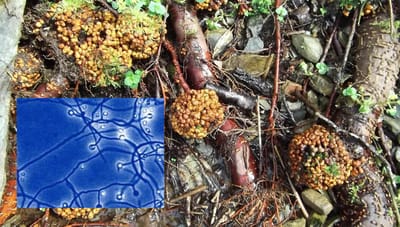
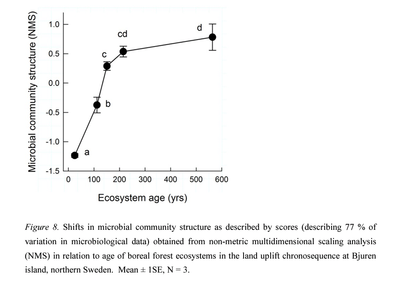
The Nitrogen Cycle in Taiga Ecosystems
Taiga ecosystems are characterized by low nitrogen availability. In his doctoral thesis, biologist Róbert Blaško investigated the development of the nitrogen cycle in boreal forests.
Many taiga trees have nitrogen fixing bacteria in their root nodules, such as the Frankia actinobacteria. These turn nitrogen from the air into nitrates the plant can use.
Despite this, Blaško found that, in his study areas in Sweden, nitrogen availability declines with ecosystem age. For example, he noticed a 20% decline in percentage of nitrogen in conifer needles when comparing a 150 and 560 year old taiga forest.
He suggested this may be due to changes in the microbial community. For example, plants more prevalent in older ecosystems may have different nitrogen fixing bacteria that provide less nitrates, or abiotic factors may arise or increase that limit nitrogen fixation.
Case Study 2
Capercaillie Tetrao urogallus as an Umbrella Species
In the Finnish Taiga, many species of fauna are suffering due to habitat loss.
The Capercaillie Tetrao urogallus, also known as just capercaillie or wood grouse, is also under threat, with their population size having decreased greatly since the middle of the last century, up to 80% in southwesterly parts of the country.
The capercaillie is a mythical bird, involved in many Finnish fairytales, making it a desirable game animal. It is also vulnerable due to its dependence on traditional courting sites, where males will arrive first and perform long and complex songs to attract females over whom they will then fight. These sites are called leks, after the Swedish word for play. If leks are disturbed, capercaillie won't mate.
In their article "Capercaillie Tetrao urogallus - A good candidate for an umbrella species in taiga forests", published in Wildlife Biology December 2003, Finnish biologists Timo Pakkala, Jani Pellikka and Harto Linden discuss their findings in an experiment designed to test for links between capercaillie leks and biodiversity.
In a study area of 465km^2 of taiga in southern Finland, a total of 41 lek sites were mapped between 1987-2002. The centre of a lek was defined by the location of the male during courting, and annual data was combined to create a centre for each lek for the study period. Throughout the study period, the number of breeding forest bird species within a 300m and 1000m radius from the centre was registered. Control sites were situated 2km southwest of each lek site, and had to be at least 1km from any other lek site.
Within a 300m radius the mean number of breeding forest bird species at lek sites was 41.2, and 36.4 at control sites. At a 1000m radius the difference was less significant but still noteworthy: mean 59.6 species at lek sites, mean 58.1 at control sites. The overall species richness of forest birds was greater in the vicinity of leks.
The tolerance range for capercaillie's leks is one in which a great species richness is possible. Large and continuous areas of forests are needed. If one were to visualize a capercaillie's tolerance curve for certain limiting environmental conditions, plotting population size on the y axis and an environmental factor on the x axis, its optimum range should be very wide in comparison to other forest species whose bell curves would fall within it as though under an umbrella (although their tolerance curves may be taller, as the capercaillie are scarce).
In protecting and managing these lek areas, foresters are thus able to make a more effective contribution to conservation than they would be if choosing areas at random. This is why capercaillie can be described as an umbrella species.
Case Study 3
Snowshoe Hare and Lynx as a Predator - Prey relationship
The snowshoe hare is adapted to its snowy environment with large and furry hind paws that allow fast movement without sinking into snow, as well as it's thick fur that protects against the cold and changes colour to help it blend into its surroundings depending on the season. The lynx also has long, dense fur and “snowshoes”, as well as excellent sight and hearing, which is aided by the tufts of fur on its ears.
Whilst the snowshoe hare is a herbivore that lives on grass, leaves and bark, the lynx is a predator, and its primary prey is the snowshoe hare. They can make up over 70% of its diet.
This famous dataset, credited to the Hudson's Bay Company, illustrates the relationship between populations of lynx and snowshoe hare in Canadian taiga.
Their population sizes increase and decrease alternately and cyclically. If hares are abundant, the lynx population will soon grow too as they have more food. When the lynx population reaches a certain size the hare population will start to shrink as so many of them are eaten by the lynx. Soon after this, the lynx population will begin to shrink due to lack of food. Now the hare population will grow again due to low predation levels. Thus, the cycle repeats itself, lasting usually about ten years.
4 Sleeping Sayan
According to Siberian legend, the guardian of the taiga is the spirit of an ancient warrior called Sayan. Sayan was so good to the taiga and it's creatures that upon his death, the gods immortalised him in stone. In the Western Sayan Mountains, he can be seen lying asleep on his back with his hands crossed on his chest, supine and serene.
Can you see him?
Nearby, a giant rock hangs over the edge of a precipice. The Hanging Rock has been immovable for tens of thousands of years, but should it ever become dislodged, it will fall into the dark waters of Lake Raduzhnoye and the splash of water will wash Sleeping Sayan's face and awaken him from his eternal slumber: time will start anew.
Cycles
Unlike energy, which is gained through sunlight and lost as heat, nutrients do not enter or leave an ecosystem but are endlessly cycled. In most cases nutrients are taken up by producers, passed to consumers when they feed, and ultimately returned to the environment, for example by saprobiotic decomposing microorganisms.
The Nitrogen Cycle
Plants and animals need nitrogen to synthesise non-essential amino acids (to make proteins) and nucleotides (to make DNA, RNA and ATP). The main source of nitrogen in a food chain is the atmosphere, which is 78% nitrogen (N₂). However, producers cannot use it in that form, and use bacteria to convert it to useable nitrogen compounds first. Nitrogen fixation processes break up the nitrogen atoms from their diatomic form. For an insight into the nitrogen cycle within the taiga biome, see Case Study 1.
1)Nitrogen Fixation
2) Ammonification
The Phosphorus Cycle
Phosphorus is equally important for organisms: it is a component of ATP, nucleic acid and phospholipids. Unlike in the nitrogen and carbon cycles, the main source of phosphorus is inorganic.
The Nitrogen Cycle
Plants and animals need nitrogen to synthesise non-essential amino acids (to make proteins) and nucleotides (to make DNA, RNA and ATP). The main source of nitrogen in a food chain is the atmosphere, which is 78% nitrogen (N₂). However, producers cannot use it in that form, and use bacteria to convert it to useable nitrogen compounds first. Nitrogen fixation processes break up the nitrogen atoms from their diatomic form. For an insight into the nitrogen cycle within the taiga biome, see Case Study 1.
1)Nitrogen Fixation
- occurs under anaerobic conditions
- bacteria in root nodules of legumes can fix nitrogen into ammonia, or NH₃ (this can later be converted to other nitrogenous compounds that will be used by the plant)
- this is because they possess the enzyme nitrogenase, which can produce two moles of ammonia from one mole of nitrogen gas
- in return, the leguminous plant supplies the bacteria with glucose (the relationship is symbiotic)
- nitrogen-fixing bacteria can also be free-living
- nitrogen fixation may also occur when lightning passes through the atmosphere as its powerful electrical energy suffices to break the strong bonds of the nitrogen molecule in the atmosphere, resulting in the formation of nitrogen dioxide which dissolves in water (rain), creating nitric acid which forms nitrates (NO₃)
- nitrogen fixation can also be conducted on an industrial scale: the Haber process is used to create ammonia for fertilisers, freeing nitrogen atoms from their diatomic form using an iron-based catalyst, and very high pressures and temperatures
2) Ammonification
- this process can occur in aerobic or anaerobic conditions but is more rapid in oxygen-rich conditions
- nitrogen compounds from dead organisms or animal waste are turned into ammonia by saprobionts
- when dissolved in water, the ammonia forms ammonium ions
- this must occur in aerobic conditions
- it constitutes the oxidation of ammonium ions into nitrate ions by nitrifying bacteria, which can then be used by plants
- firstly: certain species of nitrifying bacteria synthesise nitrite (NO₂-) ions from ammonia
- secondly: other species of nitrifying bacteria convert the nitrite into nitrate (NO₃-)
- as this process requires oxygen it is most efficient in soil with lots of air spaces, so that is well ploughed and drained
- occurs under anaerobic conditions, especially in waterlogged soil
- nitrates in soil may be converted back into nitrogen gas by denitrifying bacteria as opposed to being taken up by plants
- these bacteria use the nitrates to carry out respiration
- the nitrogen gas is rereleased back into the atmosphere; the cycle starts anew!
The Phosphorus Cycle
Phosphorus is equally important for organisms: it is a component of ATP, nucleic acid and phospholipids. Unlike in the nitrogen and carbon cycles, the main source of phosphorus is inorganic.
- for example: phosphate ions may be found in sedimentary rock
- they may become soluble in water (such as rain) and therefore available for uptake by plants / primary producers (such as by entering soil through runoff)
- consumers gain the phosphate when they eat the plants and excess ions are excreted or deposited in bones or shells
- these may later be found in sedimentary rock
- decomposition of dead animals or plants by saprobionts also releases phosphate ions that are immediately available for uptake by plants.


Biomass
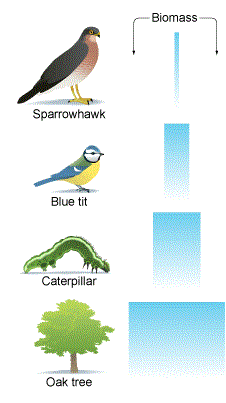
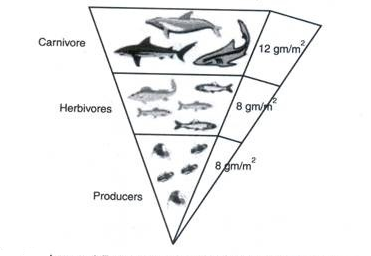
Biomass is the total mass of living material, normally measured in a specific area over a given time. “Species biomass” describes the total mass of one species, “community biomass” that of all the species within a community. Mass can be expressed by the total in a community or as average mass per unit area. The total amount of biomass produced by living organisms within a given time is known as primary productivity for producers and secondary productivity for consumers.
How biomass is measured depends on the purpose of the measurement, but can be done in several ways. For example, sometimes dry mass is used; here all water is extracted from living material before it is weighed. Sometimes only the mass of biological tissue must be measured, so bones, teeth and so on are excluded. Biomass may also be measured as that of organically bound carbon (C) within the living tissue. For example, the entire globe's live biomass has been estimated at around 550 to 560 billion tonnes C.
A food chain is organised in stages known as trophic levels. The source of energy for most food chains is sunlight, so we start at trophic level one which is comprised of autotrophic, photosynthetic organisms which manufacture organic substances using light energy, water and carbon dioxide (such as plants or phytoplankton). The next step is the primary consumer, such as a herbivorous animal or zooplankton. Carnivorous animals, or planktonivorous fish, make up the third trophic level, and are called secondary consumers. The fourth level is that of the tertiary consumer or apex predator, such as a lynx or shark.
Ecological or biomass pyramids visually describe the development of biomass throughout food chains. They are usually a pyramid shape, thinning at higher levels, as typically only 10% of energy is used to build new biomass when it's transferred from one trophic level to the next. The remaining 90% of energy is generally lost in waste or heat, or used in metabolic processes. This loss is what limits most food chains to around 5 trophic levels, and is why plants are a more efficient way to feed the human population than to eat meat. Especially in terrestrial biomes the producers will have far higher biomasses than apex predators; in their ocean or aquatic counterparts, an inversion of the pyramid is plausible. This has to do with the tiny size of phytoplankton.
Human Impacts
"Since the 1850s, the mean annual temperature in the boreal region of Canada
has risen by 0,5°C to 3°C, with increases greater than 2°C West of the Manitoba-Ontario border. The Intergovernmental Panel on Climate Change recently published its fifth assessment report, and it concluded that increases of 2°C in mean annual temperature by 2050 are highly probable, and mean annual temperatures across the Canadian boreal forest zone could be 4-5°C warmer by 2100", says Mark Johnston, Canadian forest scientist. As the global warming trend continues, the boreal forest is not left untouched. Rising temperatures will have lasting effects on it.
Within Canada, for example, warmer temperatures and changes to the distribution of annual precipitation will cause highly damaging droughts in some areas. Furthermore, large wildfires are expected to rise in number. Of course the burning of the forest itself releases CO2, perpetuating the problem. Another threat is the outbreak of forest insects. A relatively small temperature change can cause a population to explode if it moves further towards the optimum range of the species. In British Columbia, the Mountain Pine Beetle has already caused considerable damage to trees, and will probably spread eastwards in the next decades. It is also highly important to note that about 40% of the Canadian boreal forest and many taiga ecosystems across the globe are underlain by a permafrost. In many areas, this is melting and degrading irreversibly. This means that, for several decades, a repeated process of forest decline and re-establishment will occur as flora is forced to adapt to the lack of permafrost and soft, wet grounds. This process also releases significant amounts of CO2 and methane, only amplifying the greenhouse gas problem at the root of global warming.
Other pressures are human developments destructive to habitats of native plants and animals. Urban expansion, building of roads and infrastructure, the timber industry, the killing of predators to protect humans' livestock and the exploitation of minerals are some examples of practices threatening biodiversity on smaller scales. A key controversy in Canada's boreal regions is the mining of tar or oil sands. Hectares of forest must be cut down and waste products pollute land and water.
In many areas of Canada, bitumen can be found in so called tar sands. These are mined and the bitumen is processed to produce oil. Tar sands can be extracted in two ways; surface mining or well extraction. In surface mining, all trees and soil are removed to reveal oil sand deposits. The alternative method means drilling wells to reach bitumen soaked sand deposits. Both are highly damaging to surrounding ecosystems, usually taiga forest. Tar sands make up 40% of Canada’s oil production, and 20% of the USA’s annual oil consumed stems from Canadian sources. This goes to show how ingrained environmentally damaging industries are in our economy and lives.
Another important industry of Canada's which has contributed to deforestation is the timber industry, but this is now jeopardised by rising temperatures.
As temperatures rise many tree species migrate further and further north to find suitable growing conditions, although at a slower pace than climate change. Increased transformations of forests to grass or shrub lands may occur, especially under increased drought conditions. The aforementioned fire and insect outbreaks will further limit the amount of harvestable material. Climate change favours pioneer species, so hardier species which can be the first to colonize previously biodiverse, but then damaged or disrupted ecosystems. Examples are pinus and populus trees. Although climax species such as picea or abies trees may decline, this opens up opportunities for the timber industry to make use of trees such as the populus.
Altogether, it is important to remember that, as scientist Susanne Tautenhahn puts it, "boreal forests are some of the largest stores of carbon on the earth", as well as some of our most important photosynthesisers (as the largest biome on earth) and therefore any changes to them will leave a permanent impact on our global climate.
Sources
Sources
General
http://w3.marietta.edu/~biol/biomes/boreal.htm
https://askabiologist.asu.edu/explore/taiga
https://php.radford.edu/~swoodwar/biomes/?page_id=92
https://www.nationalgeographic.org/encyclopedia/taiga/
https://www.pugetsound.edu/academics/academic-resources/slater-museum/biodiversity-resources/world-biomes/characteristics-of-bioclimatic/taiga/
http://www.cotf.edu/ete/modules/msese/earthsysflr/taigaP.html
https://en.m.wikipedia.org/wiki/Taiga
Case Study 1
https://microbewiki.kenyon.edu/index.php/Frankia
https://www.intechopen.com/books/actinobacteria-basics-and-biotechnological-applications/frankia-as-a-biodegrading-agent
Róbert Blaško's doctoral thesis: https://www.researchgate.net/publication/270578207_Plant-Microbe-Soil_Interactions_and_Soil_Nitrogen_Dynamics_in_Boreal_Forests/download
Case Study 2
Timo Pakkala, Jani Pellikka & Harto Lindén's article: https://www.researchgate.net/publication/228850429_Capercaillie_Tetrao_urogallus_-_A_good_candidate_for_an_umbrella_species_in_taiga_forests
https://www.birdingbed.no/en/theme-pages/capercaillie-lek/
https://www.ephotozine.com/photo/capercaillie-lek--cairngorms-33772948
https://wildtaiga.fi/en/product/capercaillie-and-black-grouse-lek-2/
http://wyocoopunit.org/projects/umbrella-species-project
Case Study 3
Openstax Biology
http://www.torontozoo.com/ExploretheZoo/AnimalDetails.asp?pg=666
https://www.nwf.org/Educational-Resources/Wildlife-Guide/Mammals/Snowshoe-Hare
https://www.coolantarctica.com/Antarctica%20fact%20file/wildlife/Arctic_animals/arctic_hare.php
https://www.wallpaperup.com/169596/lynx_wild_cat_winter.html
Sleeping Sayan
Sleeping Sayan photo by Irina Baranova!!!
https://www.rbth.com/travel/2017/01/17/5-tales-of-siberias-indigenous-peoples_682578
http://siberiantimes.com/other/others/features/f0200-hanging-rock-defies-gravity-above-a-1000-metre-abyss/
https://eng.russia.travel/objects/322682/
http://www.sayanring.com/glossary/sleeping_sayan_eng/
Cycles
http://wxguys.ssec.wisc.edu/2018/07/09/lightning/
https://www.sciencedirect.com/topics/earth-and-planetary-sciences/ammonification
http://archive.bio.ed.ac.uk/jdeacon/microbes/nitrogen.htm
https://www.thoughtco.com/what-is-the-nitrogen-cycle-607607
Biomass
https://theearthproject.com/biomass-pyramid/
https://en.m.wikipedia.org/wiki/Biomass_(ecology)
https://m.youtube.com/watch?v=wGfOoRrICto
Human Impacts
https://www.sciencedirect.com/science/article/pii/S138993411730535X
https://www.src.sk.ca/blog/how-climate-change-will-shape-future-canadas-boreal-forest
https://www.sciencedirect.com/topics/earth-and-planetary-sciences/pioneer-species
https://www.fossweb.com/delegate/ssi-foss-ucm/Contribution%20Folders/FOSS/multimedia_ms_1E/WeatherandWater/climatefactors/regions/taiga/index.html
https://globalforestatlas.yale.edu/boreal-forest/land-use/mining-boreal-tar-sands
https://www.wri.org/blog/2014/07/tar-sands-threaten-world-s-largest-boreal-forest
https://wiki.bugwood.org/HPIPM:Mountain_Pine_Beetle
General
http://w3.marietta.edu/~biol/biomes/boreal.htm
https://askabiologist.asu.edu/explore/taiga
https://php.radford.edu/~swoodwar/biomes/?page_id=92
https://www.nationalgeographic.org/encyclopedia/taiga/
https://www.pugetsound.edu/academics/academic-resources/slater-museum/biodiversity-resources/world-biomes/characteristics-of-bioclimatic/taiga/
http://www.cotf.edu/ete/modules/msese/earthsysflr/taigaP.html
https://en.m.wikipedia.org/wiki/Taiga
Case Study 1
https://microbewiki.kenyon.edu/index.php/Frankia
https://www.intechopen.com/books/actinobacteria-basics-and-biotechnological-applications/frankia-as-a-biodegrading-agent
Róbert Blaško's doctoral thesis: https://www.researchgate.net/publication/270578207_Plant-Microbe-Soil_Interactions_and_Soil_Nitrogen_Dynamics_in_Boreal_Forests/download
Case Study 2
Timo Pakkala, Jani Pellikka & Harto Lindén's article: https://www.researchgate.net/publication/228850429_Capercaillie_Tetrao_urogallus_-_A_good_candidate_for_an_umbrella_species_in_taiga_forests
https://www.birdingbed.no/en/theme-pages/capercaillie-lek/
https://www.ephotozine.com/photo/capercaillie-lek--cairngorms-33772948
https://wildtaiga.fi/en/product/capercaillie-and-black-grouse-lek-2/
http://wyocoopunit.org/projects/umbrella-species-project
Case Study 3
Openstax Biology
http://www.torontozoo.com/ExploretheZoo/AnimalDetails.asp?pg=666
https://www.nwf.org/Educational-Resources/Wildlife-Guide/Mammals/Snowshoe-Hare
https://www.coolantarctica.com/Antarctica%20fact%20file/wildlife/Arctic_animals/arctic_hare.php
https://www.wallpaperup.com/169596/lynx_wild_cat_winter.html
Sleeping Sayan
Sleeping Sayan photo by Irina Baranova!!!
https://www.rbth.com/travel/2017/01/17/5-tales-of-siberias-indigenous-peoples_682578
http://siberiantimes.com/other/others/features/f0200-hanging-rock-defies-gravity-above-a-1000-metre-abyss/
https://eng.russia.travel/objects/322682/
http://www.sayanring.com/glossary/sleeping_sayan_eng/
Cycles
http://wxguys.ssec.wisc.edu/2018/07/09/lightning/
https://www.sciencedirect.com/topics/earth-and-planetary-sciences/ammonification
http://archive.bio.ed.ac.uk/jdeacon/microbes/nitrogen.htm
https://www.thoughtco.com/what-is-the-nitrogen-cycle-607607
Biomass
https://theearthproject.com/biomass-pyramid/
https://en.m.wikipedia.org/wiki/Biomass_(ecology)
https://m.youtube.com/watch?v=wGfOoRrICto
Human Impacts
https://www.sciencedirect.com/science/article/pii/S138993411730535X
https://www.src.sk.ca/blog/how-climate-change-will-shape-future-canadas-boreal-forest
https://www.sciencedirect.com/topics/earth-and-planetary-sciences/pioneer-species
https://www.fossweb.com/delegate/ssi-foss-ucm/Contribution%20Folders/FOSS/multimedia_ms_1E/WeatherandWater/climatefactors/regions/taiga/index.html
https://globalforestatlas.yale.edu/boreal-forest/land-use/mining-boreal-tar-sands
https://www.wri.org/blog/2014/07/tar-sands-threaten-world-s-largest-boreal-forest
https://wiki.bugwood.org/HPIPM:Mountain_Pine_Beetle
